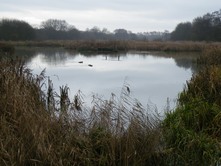

Biodiversity
Action
Plan


Standing water. Many standing water bodies remain from previous landscapes and water usage, including mill ponds and leats, farm ponds, flooded pits, subsidence flashes, drainage dykes, and reservoirs feeding canals or supplying water. These constitute many of the richest areas for wildlife.
Two thirds of all freshwater species are supported by standing water, including amphibians, dragonflies and many other aquatic insects. The loss of farm ponds largely caused the historic drop in Great Crested Newt numbers.
Priority habitat details
All standing water that supports a healthy biodiversity is a local priority habitat.
Standing open water is a broad UK BAP habitat category including Ponds and other larger national priority habitats
Standing water is identified in Phase 1 habitat surveys.
UKHab surveys identify standing open water and canals (r1).
Standing Water local priority habitat supports good populations or assemblages of key species or provides a rich site for wetland plants or invertebrates.
Pond national priority habitat has higher conditions than the local priority habitat. It consists of ponds, ditches, canals and other standing water, less than 2ha in size, supporting
- species of high conservation importance
- exceptional populations or numbers of key species - amphibian, dragon or damselfly
- exceptionally rich sites for wetland plants (≥30 species) or aquatic invertebrates (≥50 species).
The standing water habitat in Barnsley ranges from the acidic moorland reservoirs such as Winscar and lowland reservoirs like Worsbrough, to ponds, subsistence flashes, drainage dykes and canals, especially in the Dearne Valley, 240 ha in total.
Bottom-dwelling invertebrates such as snails, dragonfly larvae and water beetles are often abundant and some sites may support fish including Eel.
Amphibians including the protected Great Crested Newt can be present and Grass Snake is sometimes seen swimming across larger ponds.
Regionally scarce plants may be found in some standing water habitats, as well as Marsh Marigold, Yellow Flag and Amphibious Bistort.
Mammals such as Water Vole and Water Shrew use standing water and Daubenton’s, Noctule and Soprano Pipistrelle Bats are all found feeding on insects on or above standing water.
Standing open water also provides feeding areas for wildfowl like Mallard, Teal, Coot, Moorhen, Tufted Duck, Pochard and Goosander. In the winter, visitors from more northerly areas such as Goldeneye and Wigeon may be found.
The Dearne Valley series of wetlands and their open standing water supports important assemblages of species - breeding, migrant and wintering birds, scarce plants and insects. This has been recognised by the designation by Natural England of the Dearne Valley Wetlands as a SSSI in May 2021.
For more information on the Standing Water habitat, follow these links:

Standing Water